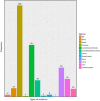Digging deeper into volatile organic compounds associated with cancer
- PMID: 32161807
- PMCID: PMC6994028
- DOI: 10.1093/biomethods/bpz014
Digging deeper into volatile organic compounds associated with cancer
Abstract
Volatile organic compounds (VOCs), produced and emitted through the metabolism of cancer cells or the body's immune system, are considered novel cancer biomarkers for diagnostic purposes. Of late, a large number of work has been done to find a relationship between VOCs' signature of body and cancer. Cancer-related VOCs can be used to detect several types of cancers at the earlier stages which in turn provide a significantly higher chance of survival. Here we aim to provide an updated picture of cancer-related VOCs based on recent findings in this field focusing on cancer odor database.
Keywords: aldehydes; cancer diagnosis; cancer odor; lung cancer; volatile organic compounds.
© The Author(s) 2019. Published by Oxford University Press.
Figures



Similar articles
-
Breath volatile organic compounds (VOCs) as biomarkers for the diagnosis of pathological conditions: A review.Biomed J. 2023 Aug;46(4):100623. doi: 10.1016/j.bj.2023.100623. Epub 2023 Jun 17. Biomed J. 2023. PMID: 37336362 Free PMC article. Review.
-
Volatile metabolomic signature of bladder cancer cell lines based on gas chromatography-mass spectrometry.Metabolomics. 2018 Apr 17;14(5):62. doi: 10.1007/s11306-018-1361-9. Metabolomics. 2018. PMID: 30830384
-
A Systematic Review and Meta-Analysis: Volatile Organic Compound Analysis in the Detection of Hepatobiliary and Pancreatic Cancers.Cancers (Basel). 2023 Apr 14;15(8):2308. doi: 10.3390/cancers15082308. Cancers (Basel). 2023. PMID: 37190235 Free PMC article. Review.
-
Identification and characterization of odorous volatile organic compounds emitted from wood-based panels.Environ Monit Assess. 2020 May 9;192(6):348. doi: 10.1007/s10661-019-7939-5. Environ Monit Assess. 2020. PMID: 32388623
-
Diagnostic Ability of Volatile Organic Compounds in Digestive Cancer: A Systematic Review With Meta-Analysis.Clin Med Insights Oncol. 2022 Jun 20;16:11795549221105027. doi: 10.1177/11795549221105027. eCollection 2022. Clin Med Insights Oncol. 2022. PMID: 35754925 Free PMC article.
Cited by
-
Theoretical basis validation and oxidative stress markers for cancer prevention clinical trials of aspirin.Sci Rep. 2023 Dec 11;13(1):21883. doi: 10.1038/s41598-023-49254-3. Sci Rep. 2023. PMID: 38072949 Free PMC article.
-
Comparative Evaluation of Volatile Organic Compounds in Two Bottle Gourd Accessions with Distinct Fruit Shapes.Foods. 2023 Oct 26;12(21):3921. doi: 10.3390/foods12213921. Foods. 2023. PMID: 37959039 Free PMC article.
-
The untargeted urine volatilome for biomedical applications: methodology and volatilome database.Biol Proced Online. 2022 Dec 1;24(1):20. doi: 10.1186/s12575-022-00184-w. Biol Proced Online. 2022. PMID: 36456991 Free PMC article. Review.
-
Identification of breath volatile organic compounds to distinguish pancreatic adenocarcinoma, pancreatic cystic neoplasm, and patients without pancreatic lesions.World J Gastrointest Oncol. 2024 Mar 15;16(3):894-906. doi: 10.4251/wjgo.v16.i3.894. World J Gastrointest Oncol. 2024. PMID: 38577457 Free PMC article.
-
Diagnosis of chondrosarcoma in a noninvasive way using volatile organic compounds in exhaled breath: a pilot study.Future Oncol. 2024;20(22):1545-1552. doi: 10.1080/14796694.2024.2355080. Epub 2024 Jun 12. Future Oncol. 2024. PMID: 38864668 Free PMC article.
References
-
- Kantarjian HM, Prat F, Steensma DP. et al. Cancer research in the United States: a critical review of current status and proposal for alternative models. Cancer 2018;124:2881–9 - PubMed
-
- Jemal A, Center MM, DeSantis C. et al. Global patterns of cancer incidence and mortality rates and trends. Cancer Epidemiol Biomarkers Prev 2010;19:1893–907 - PubMed
-
- Sung H, Siegel RL, Rosenberg PS. et al. Emerging cancer trends among young adults in the USA: analysis of a population-based cancer registry. Lancet Public Health 2019;4:e137–47 - PubMed
-
- Hiller K, Metallo CM.. Profiling metabolic networks to study cancer metabolism. Curr Opin Biotechnol 2013;24:60–8 - PubMed
-
- Chaturvedi VK, Singh A, Singh VK. et al. Cancer nanotechnology: a new revolution for cancer diagnosis and therapy. Curr Drug Metab 2018;20:416–29 - PubMed
Publication types
LinkOut - more resources
Full Text Sources
